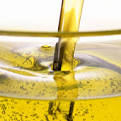Basil Exotic










Basil Exotic
Ocimum basilicum
Family Lamiaceae (Labiatae)
Synonyms Sweet basil, Comoran basil (oil) Reunion basil (oil)
General Description Botanically classified as identical from the French basil, though it is a larger plant with a harsher odour and different constituents.
Distribution Mainly produced in the Comoro Islands, but it is also processed in Madagascar.
Other Species The exotic basil is a dramatically different chemotype to the French basil and probably a separate sub-species (possibly a form of O. canum), although this has not been specified.
Essential oils are also produced in Morocco, Egypt, South Africa, Brazil and Indonesia from various chemotypes of the East India or shrubby basil (o.gratissimum), which contains a high percentage of either thymol or eugenol.
The hairy or hoary basil ( o.canum), originating in East Africa and found in India and South America, is also used to extract oils rich in either methyl cinnamate or camphor, which are produced in the West Indies and Indonesia.
Herbal/ Folk Tradition See Basil French
Extraction Essential oil by steam distillation from the leaves and flowering tops.
Characteristics The Exotic type oil is yellow or pale green, with a slightly coarse sweet herbaceous odour with a camphoraceous tinge. Its scent does not compare with the 'true' sweet basil oil.
Principal Constituents mainly methyl chavicol (70-88 per cent), with small amounts of linalol, cineol, camphor, eugenol, limonene and citronellol.
Safety Data Methyl chavicol is moderately toxic and irritating to the skin: 'the methyl chavicol content of Comoran basil is sufficient reason to discard it for therapeutic usage in favour of the French type.'
There has also been some recent concern over the possible carcinogenic effects of methyl chavicol. Basil should be avoided during pregnancy.
Aromatherapy/Home Use None.
Other Use The oil is employed in high-class fragrances, soaps and dental products; used extensively in major food categories especially meat products and savories.
Reference: The Encyclopedia of Essential Oils: Julia Lawless
Articles Latest
- Chamomile Roman - Chamaemelum nobile
- Chamomile Maroc - Ormenis multicaulis
- Chamomile German - Matricaria recutica
- From Biology To Aromatherapy
- Plant Messengers
- Celery Seed-Apium graveolens
- Cedarwood Virginian - Juniperus virginiana
- Cedarwood, Texas- Juniperus ashei - Essential oils
- Cedarwood Atlas- Cedrus atlantica - Essential Oils
- Cassie - Acacia Farnesiana - sweet acacia
- Cassia - Cinnamomum Cassia
- Cascarilla Bark - Croton eluteria
- Carrot Seed- Dacus Carota
- CARDAMON
- CARAWAY
- CANANGA
- CAMPHOR
- CALAMUS
- Calamintha-Calamintha officinalis
- CAJEPUT- Melaleuca cajeputi
- Plant Expression
Articles-Most Read
- Home
- Balsam Canadian - Abies balsamea
- Balsam Peru
- Copaiba Essential Oil
- North America: Tea Tree and Monarda-3
- Basil French - Ocimum basilicum
- Basil Exotic
- North America: Tea Tree and Monarda-2
- Exploring Transcultural Constants
- Thyme Essential Oil
- Balsam Tolu
- Palma Rosa
- Bay - West Indian - Pimenta racemosa
- The Bioactivity of Essential Oils
- Benzoin - Styrax benzoin
- Why Pharmacology Cannot Demonstrate Essential Oil Efficacy
- Exploring Essential Oil Activity The Conventional Way
- Complex information From Plants
- Aromatherapy: An Answer
- Contacts
